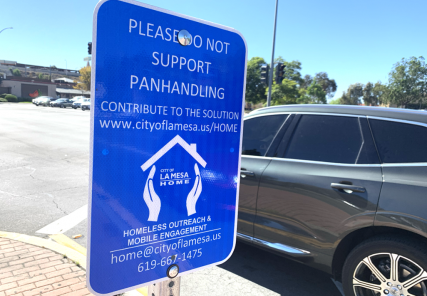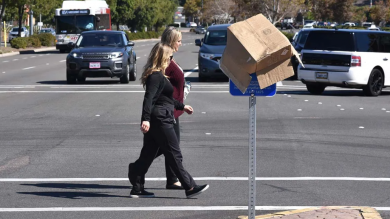By Ken Stone, Times of San Diego, a member of the San Diego Online News Association
October 28, 2022 (La Mesa) - A disabled Vietnam-era veteran named John sat under an Ikea umbrella on a La Mesa median Tuesday. He displayed a neatly lettered sign that read: “Please help with what you can. Every little bit helps, even change.”
John wouldn’t give his last name but shared that he’s been taking donations at that intersection — Fletcher Parkway and Amaya Drive — for years.
A reporter asked him if he were aware that the city had erected signs elsewhere on the main drag that read: PLEASE DO NOT SUPPORT PANHANDLING.
The signs suggested that withholding cash would contribute to solving homelessness. They gave the city’s Homeless Outreach & Mobile Engagement phone number, email address and website.
John hadn’t heard of the signs, but didn’t think they applied to him.
“I’m here because I need to make money to pay my bills,” John said on a street also named Veterans Memorial Parkway. “I have a place where I can sleep at night and have food available or I make my own food.”
He said he lived with his brother somewhere near La Mesa.
“I have a room,” he said. “That’s it.”
La Mesa City Manager Greg Humora said two signs were installed Oct. 18 on the Jackson Drive medians facing east-west Fletcher Parkway, which averages around 25,000 vehicles per day. Another is adjacent to the Costco parking lot at Marengo and Fletcher Parkway.
The Marengo sign was obscured by a cardboard box for a day or two before a Public Works employee removed it about 12:30 p.m. Tuesday. (On Wednesday, the sign bore a wig, according to a Facebook post. Another sign had the word NOT defaced.)
The employee, who declined to give his name, told Times of San Diego that similar signs were torn down at Dallas Street and Amaya Drive, apparently by people objecting to them.
Critics aren’t confined to street people.
La Mesa Councilman Bill Baber said: “I don’t support installing these signs. We need more compassion and less bureaucracy, especially for our homeless.”
City Manager Humora, a former public works director and city engineer for La Mesa, said the signs were “developed by staff to further homeless education and outreach consistent with the Homeless Action Plan.”
He noted that the signs “direct attention to the services provided by the HOME program for individuals looking to help with homelessness.”
Asked who green-lighted the signs, he replied: “Staff authorized the sign design and locations. The City Council was aware of the signs.”
He confirmed that La Mesa first learned of these types of signs when they were used by El Cajon — starting in 2017.
Any initial public reactions to the signs?
“None that I am aware of,” Humora said via email.
But he indicated the anti-panhandling program wouldn’t be expanded.
“I don’t know if more signs will go up at this point,” he said.
Asked for comment, a prominent homeless activist and former La Mesa mayor were critical of the signs.
“I’m not aware of any data on whether these signs work,” said Martha Sullivan of the San Diego Housing Emergency Alliance.
“I hope NOT, because as a formerly houseless friend told the judge in her hearing on a panhandling ticket issued by the El Cajon police: (paraphrasing) Poor people should not be punished for trying to eat.”
Sullivan conceded that the La Mesa signs don’t threaten tickets for panhandling, sometimes called “flying the sign.”
“But the reality is that millions of dollars are appropriated to ‘help’ houseless people, but very little actually reaches many of them,” she said via email. “We can see with our own eyes that the population of houseless residents continues to grow, [and] we know from recent reporting that the demand for shelter/services far outstrips the supply.”
Sullivan said that if local governments wish to reduce panhandling, they should collaborate with other local governments to supply sufficient food, housing, physical/mental health treatment (including addiction) and longterm care for elderly and/or disabled residents.
“This includes having more trained social workers interacting with houseless residents than police officers,” she said.
 Photo, right: La Mesa sign at Fletcher Parkway and Jackson Drive urging motorists not to give money to panhandlers. Photo by Ken Stone
Photo, right: La Mesa sign at Fletcher Parkway and Jackson Drive urging motorists not to give money to panhandlers. Photo by Ken StoneLa Mesa’s action plan to combat homelessness, approved in 2019, doesn’t mention posting signs against panhandling, however.
El Cajon spokesman David Richards said La Mesa staff hadn’t reached out to his City Manager’s Office about El Cajon’s signage.
“Also, we do not collect data on panhandling,” he said.
Former La Mesa Mayor Art Madrid didn’t mince words.
“I think it’s insulting, offensive and demeaning,” he said. “I can remember not too long [ago] when the son of a La Mesa councilman was homeless and the son of the mayor of El Cajon was also homeless.”
Madrid, mayor from 1990 to 2014, said there should have been discussion among top city officials.
“They should all resign because the message contradicts what La Mesa use to stand for,” he said. “Not long ago, [Councilwoman Laura] Lothian suggested that La Mesa homeless individuals should be sent to Campo.”
Former county sheriff candidate David Myers, a La Mesa resident, said: “The signs being up are definitely an indication at the failures of government and community to adequately address how people are struggling to survive, pay for gas (if they have a car), shelter, put food on the table.”
On the private Facebook group La Mesa Happenings, the signs had a mixed reception.
“Nobody panhandles because it’s fun or easier than a ‘real’ job,” said one woman. “It seems to me that these signs are likely to reduce panhandlers’ trust in the HOME program. How would you respond to someone who sees you as a problem to be removed rather than a person to assist?”
Also noting that panhandlers aren’t necessarily homeless, another woman said a panhandling neighbor in her apartment complex would make twice as much money in a day as she did at her own job.
“Just want to share a wider perspective than just folks who actually do need help,” she added.
But another woman said of panhandlers: “It’s getting very distracting trying to drive around all of them, so this will hopefully make traffic conditions safer.”
One man said he was OK with the signs.
 Photo, left: pedestrians pass anti-panhandling sign shortly before box was removed Tuesday. Photo by Ken Stone
Photo, left: pedestrians pass anti-panhandling sign shortly before box was removed Tuesday. Photo by Ken Stone“Panhandling on street corners is not a viable response to homelessness, and we really do not know whether the people doing it are homeless,” he said. “Many appear to be disabled in some way, and standing in street corners or street medians all day long is a singularly untherapeutic and unhealthy action for disabled people to be doing.”
He added: “There are no positives and no benefits to this. And there also is no evidence that people do this out of economic necessity. I would suggest you go onto Google scholar and look at the research on street corner panhandling.”
One man was blunt:
“I think the police should haul all panhandle[rs] off to a place (not jail) but a place where they can determine the help they need to get them on track to rehab themselves from whatever [their] issue is that has them there. Many are littering nuisances while some are not. Some crap and go to the bathroom behind bushes.”
But others shared sympathy for the street people:
“They’re not going to tell me what to do with hard earned money,” said one person.
“I will continue to give money to whomever I choose, whenever I choose, and for whatever reason I choose,” said another.
And John, the Amaya Drive panhandler?
He said he’s thinking of moving to another state for better veterans’ benefits.
In the meantime, he cites the law governing panhandlers — you can’t “accost” someone for money or aggressively solicit donations. Or stand within 500 feet of a freeway ramp.
How did he know these nuances?
He says he was an El Cajon cop in the 1960s.













Recent comments